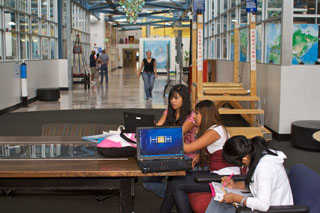
DJC.COM
August 20, 2009
My epiphany on learning: It’s the method, not the content
NAC|Architecture

Stack
|
My crystal ball is as cloudy as anyone’s, but since I spend considerable time thinking and reading about the design of spaces that house education, I do see trends.
Last year, in my article for the school design and construction supplement to the Daily Journal of Commerce, I described some of the forces, such as socialization, that will drive future school design. For this article, I want to focus on how trends might play out in the future.
First, I want to share an epiphany that I had while listening to Andrew Bunting, an Australian, at the Council of Educational Facility Planners’ Pacific Northwest Regional Conference earlier this year. That epiphany is that method, not content, is schools’ primary role in teaching students to learn.
To reinforce this concept, he asked us how many knew Australian history. Since he was the only Australian in the room, no hands were raised. He admitted that he, too, had forgotten most of what he learned about the history of Australia, and the reason was because he had been taught content, minus the method.
Let’s look at a real-life example. Many students today are enamored with “multimedia.” They describe it as their “focus” and eagerly pursue this general subject.

Photo courtesy of High Tech High At High Tech High, a San Diego charter school, students learn in an open environment structured to feel more like a workplace. |
Being a digital immigrant — I was born before computers were ubiquitous — I found myself wondering: “Why will we need so many multimedia experts? What will they do with this interest? How will it be employable?”
What I didn’t realize until I listened to Bunting is that the nature of the students’ interests doesn’t matter as much as that they are interested, and this interest drives them to delve deeper and deeper into a subject. Students learn how to research, how to collaborate, how to use technology, how to solve problems, and they are driven to acquire new skills to feed their interests. In short, they learn how to learn.
Kindle in every backpack?
Given this trend, how might learning spaces — notice I don’t say classrooms — look in the future?
First, technology will be commonplace. Spaces will be teeming with technologies that allow students to communicate, perform, collaborate, present and research without retreating to specialized rooms.
Walls of video monitors will seemingly place students in another environment. Rooms will be reconfigurable so students can broadcast themselves or the group they are working with to others in their own school or even across the world.
School environments will foster collaboration by becoming similar to design studios that balance privacy and openness. Electronic notebooks and similar devices will be inexpensive and plentiful, allowing students wireless connections to each other, teachers, parents, businesses and knowledge housed on the Web.
There has already been a proposal from the new Democratic Leadership Council to put a “Kindle in every backpack.” Students will increasingly adopt technology that allows them to stay current and to communicate.
Students will be able to explore their interests, not just in person, but also through virtual collaborations. Today, virtual worlds on the Web like Second Life enable users to interact in a simulated environment.
In the future, digital worlds designed and safeguarded for student users will make worldwide student collaboration a reality. Think about that. A student in Washington state will be able to collaborate on a virtual project with other students across the United States, and in Finland, Brazil, China or other countries. Students working on virtual projects will then share experiences with their real-world student colleagues in a seamless continuum of exploration.
Project-based learning
Schools will need to look more like the workplace and the community. We tend to think of relevant project-based learning as a new idea, but educational reformers at least as far back as John Dewey at the turn of the last century cited the advantages of experiential education.
What will differ in the future is that project-based learning will take place in, and out, of school. “Distributed education” will be the norm, with students at all levels spending part of their time learning with experts in real-world situations.
Younger students discovering how they learn best will have exposure to museums, music, performance and activities requiring movement to see which of their learning styles are the best conduit for learning. Older students will be more career-oriented, focusing on an interest that has a corollary in the working world, even if that career is not their chosen life path.
Students will need more choices to feed their passionate interests, and in so doing, round themselves into experienced learners. Schools will need to respond with more agility than is the norm today. Space will need to transform to accommodate many interests and styles, and building technology will need to evolve to find ways to allow these changes.
At the same time that technology becomes pervasive, school environments are likely to respond to the economic, social and moral reality of the times by becoming increasingly energy and resource efficient — and that, too, will become part of the learning process. Students and teachers will be actively involved in manipulating their environments to provide both the comfort they need and the configurations that serve them best.
The environment will become the “third teacher,” after the teacher and parents. Schools will need to be designed to enable easy interaction. This interaction could range from controlling environmental comfort to manipulating the shape and properties of spaces, including acoustics and surfaces.
To enable students to succeed, we will think of school as not just a single place, but a series of experiences. The “school” aspect of those experiences will have the agility to engage students with multiple learning styles in their quest to learn how to learn.
Greg Stack is a principal and the K-12 thought leader for NAC|Architecture, which has offices in Seattle, Spokane, Los Angeles, Denver and Coeur d’Alene.
Other Stories:
- South Shore campus will create a hub for the community
- Medina school celebrates cycles of nature, learning
- Architects add a new role to their job duties: facilitator
- Attention to detail makes WWU building unique
- Bouncing sounds make lecture halls tricky to design
- 7 things you need to know to build a better stage
- Robert Frost Elementary design takes road less traveled
Copyright ©2009 Seattle Daily Journal and DJC.COM.
Comments? Questions? Contact us.